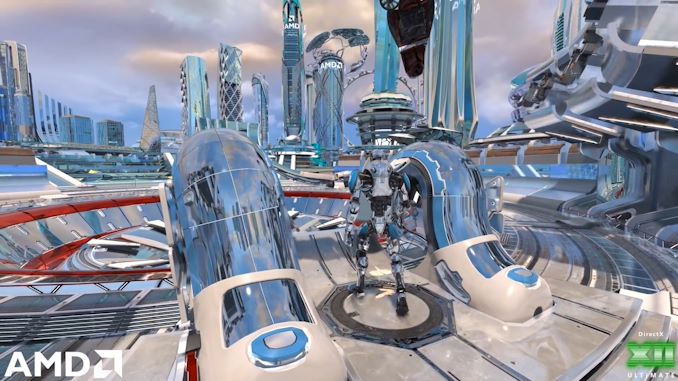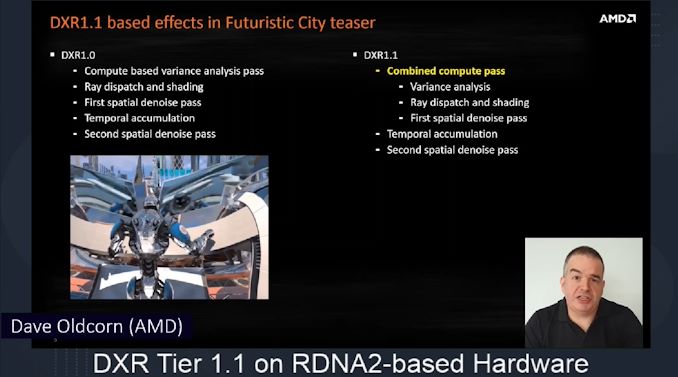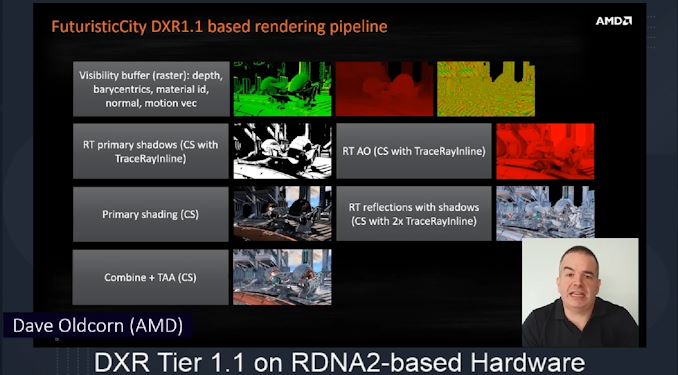Quick Note: AMD Shows Off Raytracing on RDNA2
by Ryan Smith on March 19, 2020 5:30 PM EST- Posted in
- GPUs
- AMD
- DirectX 12
- DirectX Raytracing
- RDNA2

With today’s announcement from Microsoft of DirectX 12 Ultimate, both NVIDIA and AMD are also chiming in to reiterate their support for the new feature set, and to note their involvement in the process. For AMD, DirectX 12 Ultimate goes hand-in-hand with their forthcoming RDNA2 architecture, which will be at the heart of the Xbox Series X console, and will be AMD’s first architecture to support DirectX 12 Ultimate’s new features, such as ray tracing and variable rate shading.
To that end, as part of Microsoft’s overall DirectX Developer Day presentation, AMD is showing off raytracing running on an RDNA2 for the first time in public. Running an AMD-built demo they call “Futuristic City”, the demo incorporates DXR 1.0 and 1.1 features, to produce what can only be described as a very shiny demo.
It should be noted that this demo was a recording – as all of the Microsoft dev day presentations were – though there is little reason to doubt its authenticity. AMD also showed off an RT recording a couple of weeks back for Financial Analyst day, and presumably this is the same trailer.
Source: AMD












100 Comments
View All Comments
CaedenV - Friday, March 20, 2020 - link
Big Navi is kinda like Half Life 3. It is coming... maybe... someday... it would be nice if it would come out...nt300 - Thursday, April 9, 2020 - link
Most recent rumors suggest Big Navi is going to be more than 80% faster over the current 5700XT which puts it around 30% to 35% faster over the 2080Ti. This tells me that RDNA2 is meant to compete with the 3080 series lineup.yetanotherhuman - Friday, March 20, 2020 - link
1080 Ti is still way ahead of the 5700XT. AMD haven't even reached it.blppt - Friday, March 20, 2020 - link
Well, I was giving it the benefit of the doubt...I know in at least RDR2 the 5700XT is very close to 1080ti performance, and that is probably still king of the "system melters" of AAA games currently.willis936 - Thursday, March 19, 2020 - link
It's impressive looking and all, but couldn't they have toned it down a smudge so they wouldn't have cinematic frame rates?jeremyshaw - Thursday, March 19, 2020 - link
If you have a RTRT capable card, try Quake 2 RTX.The Nvidia intern (now a PhD) who initially developed it added a hotkey to make all surfaces a reflective mirror, because he wanted to dispel the myth that mirror reflections were costly in terms of raytracing. Remember, he did most of this work years BEFORE Nvidia started moving RTX hardware, and was originally a CPU driven raytracer (before moving to CUDA, then in 2018, Vulkan RT extensions).
As we now know, clean mirror reflections are the least computationally intensive RT feature around.
Basically what I am getting at, is AMD chose all those mirrors for a reason. They cannot turn it down a smudge without lose even more performance.
whatthe123 - Thursday, March 19, 2020 - link
RT is definitely less resource intensive than the old brute force "render everything again at a mirrored angle" method, but you still need to draw on those surfaces when you make them reflective. I don't think it was a good idea to just smear mirrors everywhere. The mirrors closest to the model also look unusually blurry.I don't think a lot of thought was put into this demo. Crytek's raytracing demo was running on AMD hardware and was a much better demo of the benefits of tracing.
CiccioB - Friday, March 20, 2020 - link
Crytek raytracing demo was unveiled as a fake, as most of the ray tracing data were pre-calculated and not done real time.That's why it was so "smooth" even on a not RT HW accelerated GPU
Sefem - Saturday, March 21, 2020 - link
They are blurry because they are half resolutionSantoval - Thursday, March 19, 2020 - link
"As we now know, clean mirror reflections are the least computationally intensive RT feature around."I was unaware. So which are the most computationally intensive features of ray-tracing? Are refraction effects, caustics, indirect lighting (and, more generally, global illumination) more expensive?